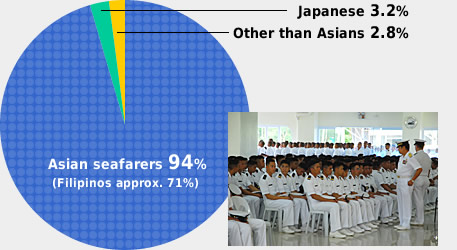


Facing a world-wide shortage of ship officers, Japan proposed, in November 2008, the ‘ASEAN-Japan Seafarer Training Cooperative Program’ to the ASEAN countries (the Philippines, Indonesia, Cambodia, Laos, Singapore, Vietnam, Thailand, Myanmar and Malaysia).
This program will be promoted not only by Japan but also in coordination with the entire ASEAN region, to achieve the following objectives:


For these objectives, we have decided together with the Philippines to promote the ‘International Cooperative Training Project for Asian Seafarers’, with the participation of the relevant governments, merchant shipping companies, labor unions, and maritime training institutes. Philippine seafarers account for about 71% of those working on board our merchant shipping engaged in foreign trade, and this trend is expected to continue.


More specifically, we intend to provide students with opportunities for shipboard training by using a Philippine training ship, thereby to give them vital knowledge and skills as seamen. In addition, we intend to promote, in coordination between the public and private sectors, upgrading of the teaching skills of Philippine instructors by dispatching to the Philippines our experts engaged in training seafarers.

With the increase of the construction of ships, as a result of an increasingly robust shipping industry worldwide, a shortage of about 27,000 ship officers is forecast for 2015 in the world. Foreign seafarers account for about 97% of those serving on board the merchant ships under the control of Japanese shipping companies. Of those foreign seafarers, Asian seamen constitute about 94%, with Philippines, in particular, about 71%. Asian seafarers account for about 44% of the seamen in the world. International competition to recruit capable Asian seafarers has recently intensified. (Figures derived from statistics by the Baltic and International Maritime Council and the International Shipping Federation)

However, maritime education institutes in Asian countries face the problem of being unable to provide their students with sufficient shipboard training opportunities, a prerequisite to obtain certificates of competency, in addition to the lack of competent instructors and less-than desirable facilities. As a result, about a half of their students abandon their studies before graduation.
A total of one year of sea experience is required to sit for an examination for a certificate of competency as a maritime officer.
